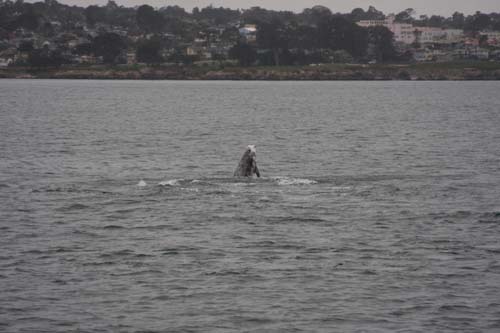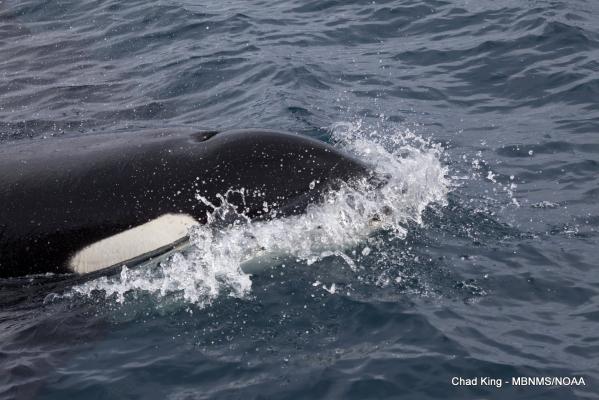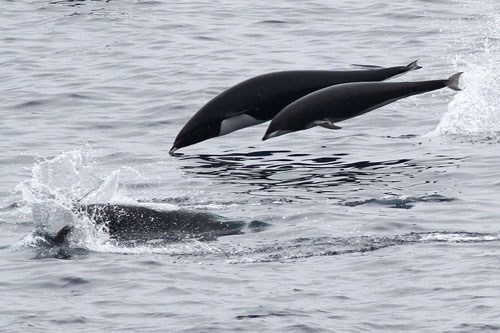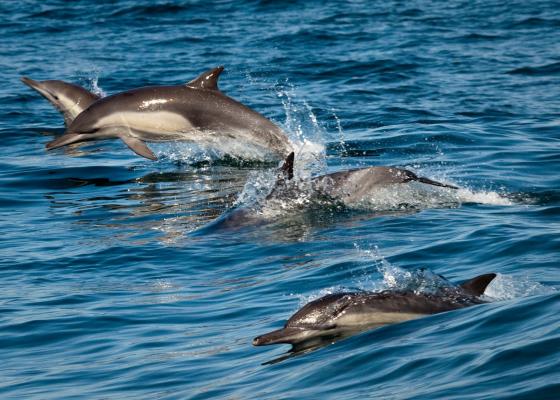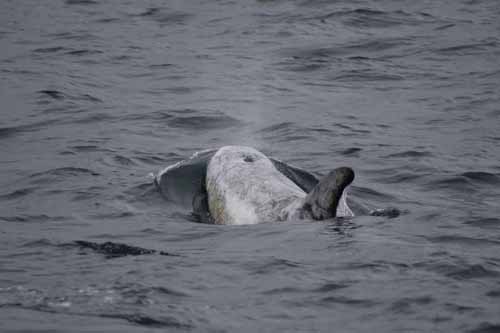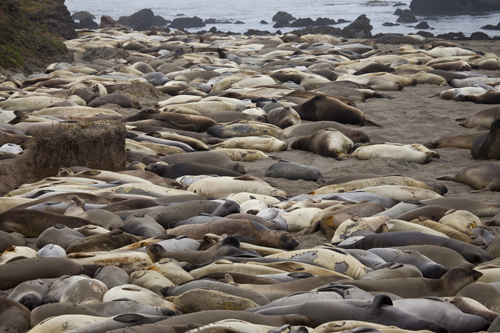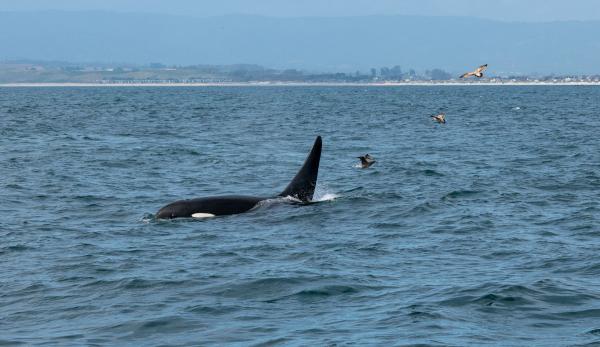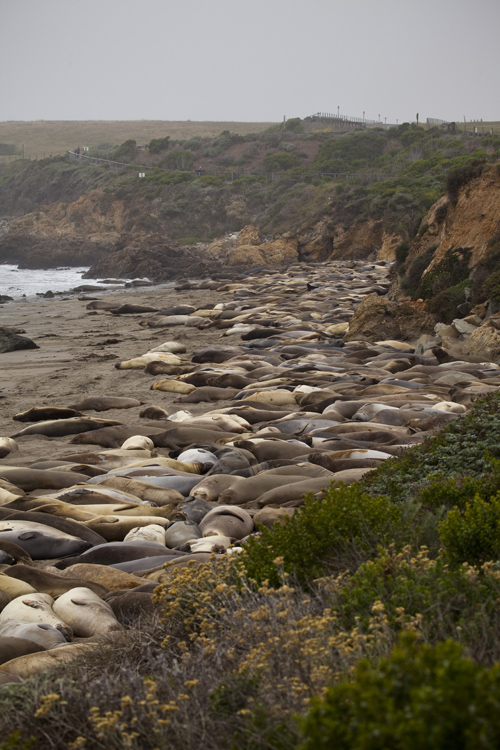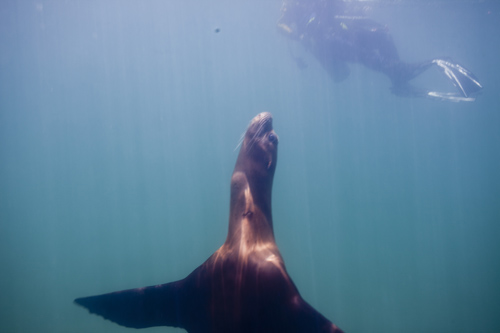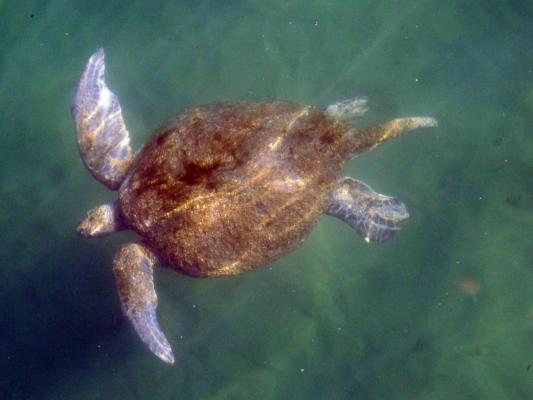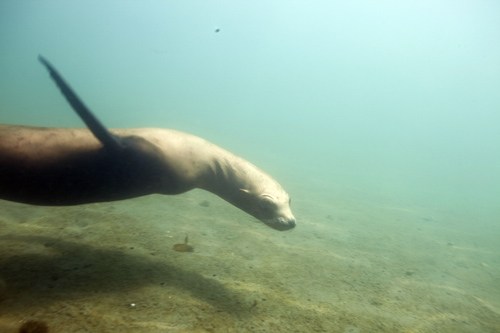Overview
Monterey Bay National Marine Sanctuary is known both nationally and internationally as a “hot spot” for viewing marine wildlife. Shorelines and offshore waters provide many opportunities for viewing whales, dolphins, seals, sea lions and sea otters.
The sanctuary has one of the most diverse and abundant assemblages of marine mammals in the world, including twenty-seven species of cetacean (whales, dolphins, and porpoises), six species of pinniped (seals and sea lions) and one species of fissiped (sea otter). This diversity and abundance is due to a number of important, related factors:
- California’s central coast is located on a migration pathway between the Arctic feeding grounds and the temperate and tropical breeding areas for many marine mammal species.
- These waters’ great productivity is enhanced by annual upwelling cycles that pull nutrients from deep-ocean canyons into the water column.
- These nutrients are consumed by planktonic organisms that support the entire food chain.
- The sanctuary’s habitat diversity provides a variety of places for marine mammals to feed, rest and breed.
- The sanctuary itself plays an important role in protecting marine mammals from harassment and exploitation.
Until recently, most of our understanding of marine mammals came from shore- and boat-based observations. New areas of study include documenting long-range migrations of animals traveling far from shore. These studies which are enabled by satellite transmitters attached to pelagic seabirds, mammals, fishes, sharks and turtles are expanding our understanding of marine wildlife and the sanctuary’s role in their feeding and migratory patterns.
Reporting tagged, sick/injured, or dead marine mammals on the beach
Following these guidelines will improve response time to the marine mammal. In all cases, do not touch or closely approach the animal, and please advise others to do the same. When contacting one of the groups below, be sure to describe the condition of the animal, its specific location, and provide your contact information.
- To report tags observed on live marine mammals, go to this web site: http://www.marinemammalcenter.org/what-we-do/rescue/report-a-flipper-tag.html
- Live stranded seal, sea lion, whale, dolphin, or turtle: call the Marine Mammal Center at 831-633-6298.
- Live or dead stranded sea otter: call the Monterey Bay Aquarium at 831-648-4840.
- Dead stranded seal, sea lion, whale, dolphin, or turtle in MONTEREY COUNTY (south of Pajaro River): call Moss Landing Marine Laboratories at 831-771-4422.
- Dead stranded seal, sea lion, whale dolphin, or turtle in SANTA CRUZ COUNTY (north of Pajaro River): call the Long Marine Lab Stranding Network at 831-212-1272.
Cetaceans
The most studied cetacean in the sanctuary is the eastern Pacific population of the gray whale, Eschrictius robustus. Gray whales spend winter months in shallow lagoons in Baja California, Mexico. Calves are born there, and the whales mate in the tropical waters.
In the spring, they migrate north through the sanctuary to rich feeding areas in the Bering, Beaufort and Siberian Seas. Then, as sea ice forms in winter, the whales head south again. This annual voyage along North America’s West Coast can be as long as 17,700 kilometers (11,000 miles).
In the 1700s, whalers followed the gray whale migration to hunt and slaughter the giants for whale oil and other products. Lookouts were placed along points and promontories, and when whales were sighted, shore whaling vessels were launched. Some of California¹s coastal towns, including San Simeon and Pacific Grove, were whaling stations.
Today, researchers use the very same lookout spots to monitor and count the whales on their annual migration.
Now protected from whalers, gray whales are still hunted by predatory orcas (killer whales), Orcinus orca. Hunting in family groups, or pods, orcas follow gray whale cow-calf pairs on their spring northward migration and attack them as they cross Monterey Bay.
Other large whales, including blue whales, Balaenoptera musculus musculus, and humpback whales, Megaptera novaeangliae, move into the sanctuary in the summer and fall to feed in its productive waters. Movements of smaller cetaceans are likely associated with local changes in oceanographic conditions and prey abundance.
Pinnipeds
Of the six pinniped species found in the sanctuary, three are commonly seen from shore: the California sea lion, Zalophus californianus; the northern elephant seal, Mirounga angustirostris; and the Pacific harbor seal, Phoca vitulina. The northern fur seal, Callorhinus ursinus, migrates in offshore waters and is rarely seen near land. The Steller sea lion, Eumetopias jubatus, has experienced declining numbers throughout its range, while the Guadalupe fur seal, Arctocephalus townsendi, has been reported from stranding records.
Pinnipeds use sanctuary waters for feeding, migration and breeding.
In the spring months, sea lions and fur seals migrate through the sanctuary to breeding areas in southern California and Baja California, including the Channel Islands National Marine Sanctuary. In August and September, they take advantage of late summer productivity along the central coast to travel to northern feeding areas.
Sea lions can be observed resting on offshore rocks throughout the Monterey Bay sanctuary. Some sea lions become accustomed to human environments and haul out on docks and piers, begging for food from eager tourists.
During winter months, northern elephant seals travel through the sanctuary on their way to and from breeding areas. Most elephant seals breed on the Channel Islands, while some travel as far south as Baja California.
The easiest places to observe elephant seals during their breeding season are Año Nuevo and Piedras Blancas:
- Año Nuevo Island supports a large elephant seal breeding colony, which researchers at UC Santa Cruz have monitored and studied since its inception in 1968. Elephant seals began pupping and breeding on the mainland at Año Nuevo, and since then, several other mainland colonies have developed.
- Piedras Blancas has the largest mainland colony of northern elephant seals, with more than 14,000 individuals during the peak season (January to March).
Harbor seals haul out on nearshore rocks, intertidal shelves and isolated beaches throughout the sanctuary to rest and bear their young. Divers often encounter Harbor seals underwater, primarily due to the curiosity of the seals. Residential or non-migratory, Harbor seals stay fairly close to their hauling sites throughout their lives.
Elkhorn Slough supports a large population of Harbor seals, and another very scenic place to observe them is Point Lobos State Reserve. Harbor seal pupping occurs from February into May. One of the best places to observe harbor seals during the pupping season is at Hopkins Marine Life Refuge, where these seals give birth and nurse pups only meters away from downtown Monterey.
Sea Otter
Sea otters once occurred in a continuous range from the Aleutian Islands south to Baja California, but excessive hunting in the 1700s nearly wiped out the species. A small group survived the fur trade and was discovered off Point Sur in 1938 during the construction of the Big Sur Highway.
This group has expanded north and south, with most of its range occurring within the sanctuary. For decades now, the population has wavered around 2,300 to 2,500 animals.
Monitoring
Tagging of Pacific Pelagics (TOPP)
Since 2000, TOPP had been exploring the Pacific Ocean using a carefully selected group of animals to gather data about their world. A pilot program of the Census of Marine Life, it is an international endeavor to determine what lives, has lived and will live in the world’s ocean. Ultimately, scientists will draw upon their data to build models of Pacific ecosystems.
Collaborative Survey of Cetacean Abundance and the Pelagic Ecosystem (CSCAPE)
West Coast CSCAPE is a collaboration between NOAA Fisheries and the National Marine Sanctuary Program to assess the abundance and distribution of marine mammals and to characterize the pelagic ecosystem out to approximately 300 nautical miles off the U.S. West Coast.
Center for Integrated Marine Technologies (CIMT): Wind to Whales
CIMT is an interdisciplinary coastal research consortium that integrates data collected via remote sensing, moorings and ship-board surveys in the Monterey Bay region. CIMT uses these technologies to investigate linkages among coastal upwelling, nutrient delivery, phytoplankton and organisms at higher trophic levels (squid, fishes, seabirds, sea turtles, seals and whales).
Photos
Maps
Projects
Beach Watch
Beach Watch is a long-term, beach-monitoring project. Beaches surveyed stretch from Bodega Head in Sonoma County down to Año Nuevo in San Mateo County. Volunteers survey a designated beach segment counting, identifying, and photo-documenting live and dead birds and marine mammals and human activity on- and immediately offshore.California Cooperative Oceanic Fisheries Investigations (CalCOFI)
The California Cooperative Oceanic Fisheries Investigations (CalCOFI) was formed in 1949 to study the ecological aspects of the Pacific sardine population collapse off California. Today, the focus has shifted to the study of the marine environment off the coast of California, the management of its living resources, and monitoring the indicators of El Nino and climate change.
Center for Integrated Marine Technologies: Wind to Whales
The Center for Integrated Marine Technologies' (CIMT) mission is to create a coastal ocean observing and forecasting system that provides a scientific basis for the management and conservation of Monterey Bay, and serve as a model for all of California\'s coastal marine resources and the U.S. Integrated Ocean Observing System (IOOS).Coastal Ocean Mammal and Bird Education and Research Surveys (Beach COMBERS)
In 1997, we began a beach survey program called Coastal Ocean Mammal and Bird Education and Research Surveys (Beach COMBERS) using trained volunteers to survey beached marine birds and mammals monthly at selected sections of beaches from Wadell Creek to Morro Bay.Concentrations and Effects of Environmental Contaminants on the Health of California Sea Otters
This project examined liver tissue collected from 80 female sea otters during necropsies between 1992 and 2002. These females were collected from the coast of California within the Monterey Bay National Marine Sanctuary. Concentrations of some contaminants were higher in females that died from infectious diseases than in females that died from either emaciation or non-infectious causes. This link between contaminant burden in sea otters and susceptibility to disease is being actively pursued.CSCAPE: Collaborative Survey of Cetacean Abundance and the Pelagic Ecosystem.
CSCAPE is a collaboration between the National Marine Fisheries Service and the National Marine Sanctuary Program to assess the abundance and distribution of marine mammals and to characterize the pelagic ecosystem out to ~300 nautical miles off the U.S. West Coast.Davidson Seamount 2015: Characterization of Mammals, Birds, and Midwater Fishes Above and Adjacent to Davidson Seamount
This multi-disciplined and complex research mission accomplished most of the research goals for areas within the Davidson Seamount Management Zone and other Sanctuary Ecologically Significant Areas (SESAs). The NOAA fishing survey vessel, "Bell M. Shimada" was used as the operational platform. Individual projects completed included the recording of marine mammal and ocean noise with hydrophones, oceanographic data and water sampling with a CTD, collection of water samples for Fukushima isotope analysis (with a CTD), collection of water samples for environmental DNA analysis (with a CTD), mesopelagic fish surveys (with a tucker trawl), marine mammal and seabird surveys were conducted above and adjacent to Davidson Seamount (although most of the surveys occurred in a Beaufort state 6 or above, making the data incomprable), and filming for video production of NOAA research and collaborative Marine Biodiversity Observatory Network (MBON) was completed. Additional proposed research that could not be completed due to ocean conditions included Puma drone surveys to observe marine mammals at DSMZ. Media Day was held off the wharf in Santa Cruz.Davidson Seamount: 2010 Marine Mammal & Seabird Survey
MBNMS staff and UCSC scientists conducted a ship-based survey of the waters above and around the Davidson Seamount for three days in July 2010. Efforts aboard the NOAA Ship McArthur II represent the first dedicated at-sea surveys of Davidson Seamount for marine mammal and seabirds.Davidson Seamount: 2010 Marine Mammal Aerial Surveys
In 2010, the Monterey Bay National Marine Sanctuary (MBNMS) and its partners conducted two aerial surveys of the surface waters surrounding the Davidson Seamount, an area typically regarded as having a higher abundance and diversity of marine mammals and seabirds.Effect of the Moss Landing Power Plant thermal discharge plume on the distribution and behavior of sea otters (Enhydra lutris nereis): a preliminary study
Southern sea otters (Enhydra lutris nereis) have occupied various parts of Elkhorn Slough over the past few decades. Recently, a large raft of otters has been noted just within the Moss Landing harbor entrance. In addition, some otters have been observed within and adjacent to the thermal plume generated by the Moss Landing Power Plant. This project studies sea otter behavior in and adjacent to the plume.Field Test of the Puma™ AE (All Environment) Small Unmanned Aircraft System (UAS)
This field-test project used a waterproof, all-electric propeller powered small unmanned aircraft system to find and transmit live video of marine mammals to observers aboard a support vessel in northern Monterey Bay in September 2014. The purpose of this project was to test the efficiency of the aircraft, its reliability in resolving different marine mammal species, and its capability of running more rigorous and traditional transects. Although it proved successful in finding marine mammals, and lacked mechanical problems, it can yet be used to obtain marine mammal densities due to the inability to calculate ocean surface area covered during a flight. In its current configuration, this small unmanned aircraft system may be better suited for reconnaissance and enforcement applications within Monterey Bay National Marine Sanctuary.Literature Review To Characterize Environmental Contaminants That May Affect The Southern Sea Otter
The objectives of this study are to characterize environmental contaminants present in sea otter habitats that may affect population recovery, synthesize existing data on contaminant concentrations, and map their distribution.Long-term monitoring of Northern Elephant Seals: colony development and growth rates in the Monterey Bay National Marine Sanctuary
We initiated a study of the population in 1968 involving systematic censuses and mark/recapture studies on the major rookeries which continues to the present; this long-term study permits a detailed documentation of population growth and colonization of the Sanctuary via dispersion and emigration.Marine Life Studies' Research Scientist Program
Marine Life Studies is a nonprofit organization committed to protecting our ocean, whales, dolphins and other marine wildlife, whose mission is to acquire knowledge and share knowledge and inspire the next generation of whale, dolphin and ocean conservationists.Monitoring whales by Cascadia Research Collective
Cascadia Research is a non-profit (501c3) scientific and education organization based in Olympia, Washington, USA. We primarily conduct research needed to manage and protect threatened marine mammals.Nutritional Constraints on Sea Otters in the Monterey Bay National Marine Sanctuary
We are investigating nutritional constraints on southern sea otters (Enhydra lutris nereis) by examining the nutrient composition of sea otter prey while coupling these data with studies on otter foraging behavior.Photo-identification of Blue Whales
The focus of this project is to collect identification photographs of blue whales to examine movements, migratory destinations, stock structure, and behavior, and to estimate abundance and trends in abundance.Point Lobos State Reserve Otter Survey
Monthly land-based standardized surveys of southern sea otters are conducted by Point Lobos volunteers to determine population trends in the reserve area.Point Piedras Blancas Northern Elephant Seal Monitoring
Monitoring at Piedras Blancas began in 1990 and annual surveys indicate the Northern Elephant Seal population has steadily increased.Point Reyes National Seashore Northern Elephant Seal Monitoring
Breeding records of elephant seals have been kept since their return to the Point Reyes Headlands in 1981. This program includes park staff, college students, and community volunteers in the survey effort.Structure of Populations, Levels of Abundance and Status of Humpbacks (SPLASH)
SPLASH is an international cooperative effort to understand the population structure of humpback whales across the North Pacific, and to assess the status, trends and potential human impacts to this population. The project has broad international and national participation.Tagging of Pacific Predators (TOPP)
The Tagging of Pacific Pelagics (TOPP) research program aims to understand the migration patterns of large predators in the North Pacific basin and how these animals act and interact in their open ocean habitats. By using satellite tagging techniques, TOPP researchers follow the movements of different species across multiple trophic levels (i.e., the food web) and in relation to physical oceanographic features in order to piece together a whole ecosystem picture.Underwater Behavior of Large Whales Using Suction-cup Attached Tags
This project examined underwater movements, behavior, and vocalizations of individual blue, fin, and humpback whales using suction-cup tags. Tags included a variety of instrument packages.USGS Sea Otter Survey in California
Bi-annual aerial and land-based standardized surveys of southern sea otters have been conducted in California during late spring and early fall, since 1983. The surveys record the total otter numbers, the number of dependent pups, and the number of adults and sub-adults, or independents observed. Spring survey results are used as an indicator of the population trend of California sea otters.
Links
Año Nuevo State Park - Northern Elephant Seals
California State Parks website for Año Nuevo, the site of the largest mainland breeding colony in the world for the northern elephant seal.http://www.parks.ca.gov/default.asp?page_id=523
American Cetacean Society - Monterey Bay Chapter
Find out more about what the local chapter of the American Cetacean Society does to expand scientific knowledge of these fascinating creatures.http://www.acsmb.org/
David's Whale and Dolphin Watch
Image library with many whale and dolphin images, organzied by species. Site also provides links to other pages.http://neptune.atlantis-intl.com/dolphins/index.html
Defenders of Wildlife - Sea Otter educational unit
This unit focuses on sea otters of California, Oregon, and Washington and is available in English and Spanish.http://www.kidsplanet.org/espanol/espint.html
Discovery of Sound in the Sea
This web site will introduce you to the science and uses of sound in marine research.http://omp.gso.uri.edu/dosits/dosits.htm
Lawrence Hall of Science (UC Berkeley) - Whale Sounds
Online whale sound activity that includes recorded whale sounds and discusses communication and echolocation, the term that describes how many marine mammals "see with sound" underwater.http://lhs.berkeley.edu/WHALE
List of links provided by SeaWorld
SeaWorld and Walt Disney World provide a list of links with Orca information.http://www.orlandofuntickets.com/the-sea-life-of-orca-whales.php
List of Marine Mammal Species and Subspecies
The Ad-Hoc Committee on Taxonomy, chaired by Bill Perrin, has produced the first official Society of Marine Mammology list of marine mammal species and subspecies. Consensus on some issues was not possible; this is reflected in the footnotes.http://www.marinemammalscience.org/index.php?option=com_content&view=article&id=420&Itemid=280
MARE: Marine Activities, Resources and Education
MARE is an interdisciplinary science program at the Lawrence Hall of Science (UC Berkeley) offering year-round professional development opportunities, including events that immerse your whole school—faculty, students and families—in the study and celebration of the ocean.http://www.lawrencehallofscience.org/MARE/
Monterey Bay Aquarium - Student and Teacher Resources and Activities
The Monterey Bay Aquarium offers teacher and student resources including: species and habitat-specific information, live cams, classroom activities, and interactive online games.http://www.mbayaq.org/lc/
Monterey Bay National Marine Sanctuary - Marine Mammals
A comprehensive and educational scientific characterization of important creatures in the Monterey Bay Sanctuary.http://montereybay.noaa.gov/sitechar/mamm.html
Monterey Bay National Marine Sanctuary - Slideshow
Slideshow that includes photos of landscapes, marine mammals, birds and other organisms found in the Monterey Bay.http://montereybay.noaa.gov/visitor/slideshow/slideshow.html
Monterey Bay Whale Watch - Marine Life of the Bay
Photos and brief descriptions about local marine mammals and other marine wildlife from the Monterey Bay.http://www.montereybaywhalewatch.com/marlife.htm
Monterey Bay Whale Watch - Marine Mammal Sightings in the Monterey Bay Region
View a list of the most recent marine mammal sightings logged by Monterey Bay Whale Watch. This list is constantly updated.http://www.montereybaywhalewatch.com/sighting.htm
National Marine Mammal Laboratory
The National Marine Mammal Laboratory (NMML) conducts research on marine mammals worldwide, concentrating primarily in coastal California, Oregon, Washington and Alaska.http://nmml.afsc.noaa.gov/
NOAA National Marine Mammal Laboratory
Marine Mammal Education Web hosted by NOAA's Alaska Fisheries Science Center.http://www.afsc.noaa.gov/nmml/education/marinemammals.php
NOAA Photo Library
NOAA's photo library contains incredible shots of an amazing array of animals, technology, scientists, and images of historical treasures. Site also offers search function for images.http://www.photolib.noaa.gov
OBIS-SEAMAP: Ocean Biological Information System - Spatial Ecological Analysis of Megavertebrate Populations
A digital database of marine mammal, seabird, and sea turtle distribution and abundance. The web-based system will allow the interactive display, query, and analysis of the digital archive in conjunction with environmental data.http://seamap.env.duke.edu/
Save the Whales
Save The Whales is a non-profit organization whose mission is to educate children and adults about marine mammals, their environment and their preservation. Save the Whales is based in Monterey, and their website provides information on free class presentations, Adopt-A-Whale programs and general information about local marine mammals.http://savethewhales.org
SLEWTHS: Science Learning and Experimenting with the Help of Sea Lions
Research project that studies marine mammals, with sea lions and people working together. Sponsored by Moss Landing Marine Lab, the program also offers classes, internships and other learning opportunities.http://slewths.mlml.calstate.edu/
SORAC: Sea Otter Research and Conservation
Find out what the Monterey Bay Aquarium is doing to learn more about how to conserve the California sea otter.http://www.mbayaq.org/cr/sorac.asp
Tagging of Pacific Predators: near real-time animal tracks
Images of near real-time satellite tracking data of pelagic species of sharks, mammals, and turtles.http://topp.org/
The Marine Mammal Center
Learn more about an organization that rescues, rehabilitates, releases, teaches about and researches marine mammals.http://www.marinemammalcenter.org/
The Otter Project
The Otter Project exists to promote the rapid recovery of the California sea otter, an indicator of near shore ocean health, by facilitating research and communicating research results to the general public and policy makers.http://www.otterproject.org
USGS Western Ecological Research Center - Sea Otter Research
The U.S. Geological Survey Western Ecological Research Center (USGS WERC) maintains expertise on sea otters in California, Washington, and Alaska, and works with state, federal, and local partners throughout the species' range. The Center, located in Santa Cruz, is the repository for data on both the threatened California sea otter population and the state-listed Washington sea otter population.http://www.werc.usgs.gov/project.aspx?projectid=91
Whale Acoustics
A company that works with federal agencies to study man-made noise impacts on whales and the use of passive acoustics to develop census methods for whales.http://www.whaleacoustics.com
Whale sightings by Sanctuary Cruises
The Captain's log is the latest in whale sightings information in Monterey Bay as collected by Sanctuary Cruises.https://sanctuarycruises.com/captains_log/
WhaleNet
WhaleNet is an interdisciplinary, student-centered, interactive educational program focused on whales, the marine habitat, and environmental studies. Some activities are available on-line, some can be ordered for an additional charge.http://whale.wheelock.edu/Welcome.html
WhaleNet Guide to Whales & Marine Mammals of the North Atlantic Ocean
CDROM with educational materials on Marine Mammals of the North Atlantic.http://whale.wheelock.edu/whalenet-stuff/CDROMintro.html
